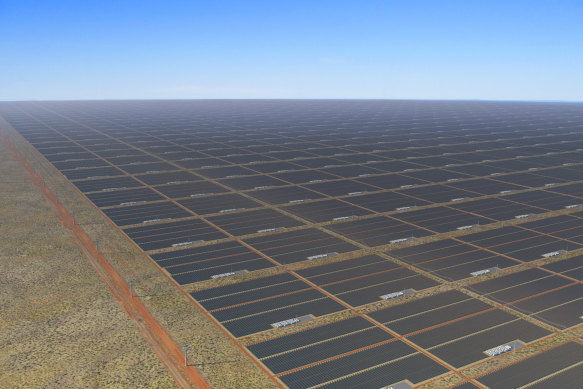Mike Cannon-Brookes, billionaire co-founder of software giant Atlassian, is known for betting big on the radical transformation of the energy sector and the outsized role Australia could play in it.
No bet is bigger than SunCable, his $35 billion mega-project vying to build the world’s largest solar and battery farm in the Northern Territory and connect it to Singapore via a 4300-kilometre transmission cable along the ocean floor. “It’s time to stretch our country’s ambition,” Cannon-Brookes believes.
Whether SunCable is stretching too far is a question that divides many and has dogged the project from the start. Critics insist it’s too ambitious, too gigantic an undertaking to ever make sense economically. Even Cannon-Brookes once remarked the idea sounded “bat-shit insane” the first time he heard about it.
Growing unease about the long-shot project came to a head last year, forcing SunCable into administration amid an irreconcilable clash between Cannon-Brookes and the venture’s other major financier, mining magnate Andrew Forrest, who no longer thought the far-flung Darwin-Singapore connection stacked up.

A rendering of the Sun Cable’s proposed solar and battery farm near Tennant Creek, which could become Australia’s biggest renewable energy project.Credit: Artist’s impression
Cannon-Brookes, for his part, has been steadfast in supporting the rationale for the flagship Australia-Asia PowerLink – we have some of the sunniest land on Earth, he declares. What if we could harness more of that solar energy potential and share it with power-hungry customers in Singapore who urgently want to decarbonise but lack the space to build large-scale renewables of their own?
His private company, Grok, went on assemble the consortium that acquired SunCable back from administrators and remains committed to the full scope of its ambition to supply clean electrons to Darwin and south-east Asia.
Last week, just over a year since the sale was finalised, Cannon-Brookes and his team notched a major milestone, one they said was a “vote of confidence” in SunCable’s prospects that brings it a step closer to fruition.
At an industry conference in Singapore on Tuesday, the city-state’s energy market authority revealed it had awarded SunCable conditional approval to export low-carbon electricity from its project in Australia, having concluded that the proposal “can be technically and commercially viable”.
Loading
Jeremy Kwong-Law, Grok’s chief investment officer, sees the green light as an important statement that “we are definitely in the game”, even as Singapore has been awarding similar early approvals to others offering to supply low-carbon power from closer neighbours than Australia, including Cambodia, Indonesia and Vietnam.
“We’ve always believed that the industrial logic of exporting electricity via cable to Singapore is very compelling because we have very good renewable resources in Australia – some 40 per cent better yield compared to anywhere in south-east Asia that is exporting into Singapore,” Kwong-Law says.
This means SunCable has the advantage of being able to offer continuous clean power to Singapore day and night, he adds, “whereas most of the other projects in the region are 16-17 hours a day because they don’t have as much sun, and therefore will need to build too much solar and too many batteries to make it economic”.
Singapore, which relies on burning natural gas for 95 per cent of its electricity needs, this year increased its target for how much low-carbon power it plans to import from neighbours by the mid-2030s from four gigawatts to six gigawatts — enough to account for about 30 per cent of its estimated demand.
For SunCable, obtaining Singapore’s conditional approval means it can press ahead with the next phase of development. This includes talks with potential industrial energy customers in Singapore, such as the country’s big energy retailers, and technology companies such as data centres, which require huge amounts of electricity to run high-intensity computing and cooling systems and are expected to drive significant growth in the coming decade.
To acquire SunCable from administration, Grok teamed with Quinbrook Infrastructure Partners – a global investor with extensive experience developing major solar power and storage projects in the United States and United Kingdom.
Loading
So far, Quinbrook is limiting its involvement to the onshore arm of the Australia-Asia PowerLink, meaning the full project is being developed in stages – the first being the solar and battery farm near Tennant Creek, plus the 800-kilometere transmission link to Darwin, the second being the giant Singapore high-voltage transmission corridor.
Grok is targeting a final investment decision on the project in 2027, with an aim to be delivering green power to Singapore sometime shortly after 2035.
Major hurdles still remain, given the eye-watering magnitude of the ambition – SunCable’s proposed link to Singapore would be about six times longer than today’s longest underwater transmission line, the 764-kilometre Viking Link.
But Kwong-Law says SunCable is excited to have been awarded conditional approval, a milestone some critics had been doubtful would occur.
“We know that the Singaporeans wanted green electrons, we knew we could supply them at a price we think is highly competitive and we knew the high-voltage direct current technology works,” he says.
“It’s good, in times like this, when your convictions hold true.”
The Business Briefing newsletter delivers major stories, exclusive coverage and expert opinion. Sign up to get it every weekday morning.

